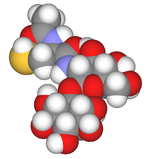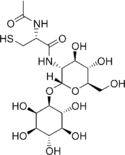Chemistry:Mycothiol
|
| |||

| |||
| Names | |||
|---|---|---|---|
| IUPAC name
(2R)-2-acetamido-N-[(2R,3R,4R,5S,6R)-4,5-dihydroxy-6-(hydroxymethyl)-2-[(2R,3S,5R,6R)-2,3,4,5,6-pentahydroxycyclohexyl]oxyoxan-3-yl]-3-sulfanylpropanamide
| |||
| Other names
Mycothiol
| |||
| Identifiers | |||
3D model (JSmol)
|
|||
| ChEBI | |||
| ChemSpider | |||
| KEGG | |||
PubChem CID
|
|||
| |||
| |||
| Properties | |||
| C17H30N2O12S | |||
| Molar mass | 486.49 g/mol | ||
Except where otherwise noted, data are given for materials in their standard state (at 25 °C [77 °F], 100 kPa). | |||
| Infobox references | |||
Mycothiol (MSH or AcCys-GlcN-Ins) is an unusual thiol compound found in the Actinomycetota.[1][2] It is composed of a cysteine residue with an acetylated amino group linked to glucosamine, which is then linked to inositol.[3] The oxidized, disulfide form of mycothiol (MSSM) is called mycothione, and is reduced to mycothiol by the flavoprotein mycothione reductase.[4][5] Mycothiol biosynthesis and mycothiol-dependent enzymes such as mycothiol-dependent formaldehyde dehydrogenase and mycothione reductase have been proposed to be good drug targets for the development of treatments for tuberculosis.[6][7]
See also
- Glutathione, analogous function in other Bacteria
- Bacillithiol
References
- ↑ Fahey RC (2001). "Novel thiols of prokaryotes". Annu. Rev. Microbiol. 55: 333–56. doi:10.1146/annurev.micro.55.1.333. PMID 11544359.
- ↑ Jothivasan VK, Hamilton CJ, (2008) Mycothiol: synthesis, biosynthesis and biological functions of the major low molecular weight thiol in actinomycetes. Natural Product Reports, (25). 1091-1117 [1]
- ↑ "Biosynthesis and functions of mycothiol, the unique protective thiol of Actinobacteria". Microbiol. Mol. Biol. Rev. 72 (3): 471–94. September 2008. doi:10.1128/MMBR.00008-08. PMID 18772286.
- ↑ "Expression, purification, and characterization of Mycobacterium tuberculosis mycothione reductase". Biochemistry 38 (36): 11827–33. September 1999. doi:10.1021/bi991025h. PMID 10512639.
- ↑ "Mycobacterium tuberculosis mycothione reductase: pH dependence of the kinetic parameters and kinetic isotope effects". Biochemistry 40 (17): 5119–26. May 2001. doi:10.1021/bi0029144. PMID 11318633.
- ↑ "Mycothiol-dependent proteins in actinomycetes". FEMS Microbiol. Rev. 31 (3): 278–92. April 2007. doi:10.1111/j.1574-6976.2006.00062.x. PMID 17286835.
- ↑ "Mycothiol biochemistry". Arch. Microbiol. 178 (6): 388–94. December 2002. doi:10.1007/s00203-002-0469-4. PMID 12420157.
Mycobacterium tuberculosis is extraordinarily sensitive to killing by a vitamin C-induced Fenton reaction Published 21 May 2013. Nature Communications4, Article number:1881 doi:10.1038/ncomms2898
External links
 |



